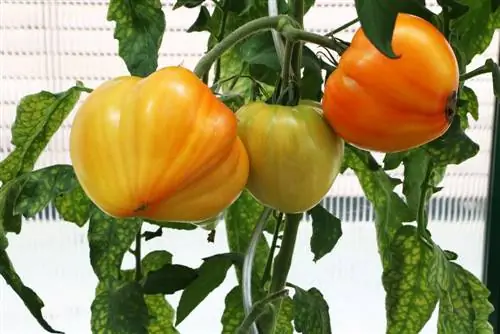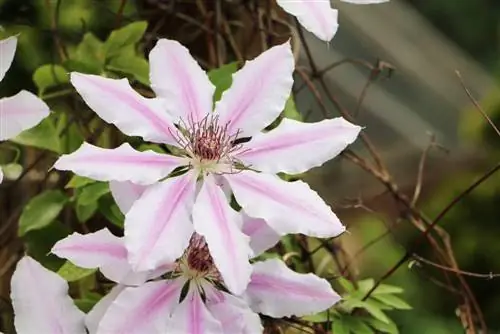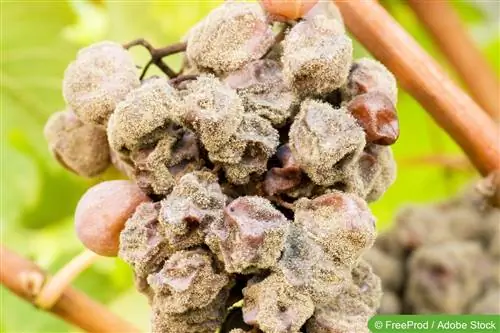- Author admin [email protected].
- Public 2023-12-17 03:39.
- Last modified 2025-01-24 12:45.
Eye fungi are responsible for the so-called late blight. The species Phytophthora infestans infects various nightshade plants such as the tomato (Solanum lycopersicum) and causes typical symptoms on the plant parts.
Typical symptoms
You can recognize the beginning of an infection by blurry spots on leaves and stems. If the fungus spreads unhindered, the entire plant dies. As soon as you notice noticeable discoloration on the fruits, they are no longer edible. These phenomena characterize tomato disease:
- Leaf tips appear brown
- a bright fungal lawn develops on the underside of the leaf
- withered leaves rot and appear black in color
- Fruits initially have green-gray to brown spots
- Rot sets in until tomatoes fall off
Remove plant parts
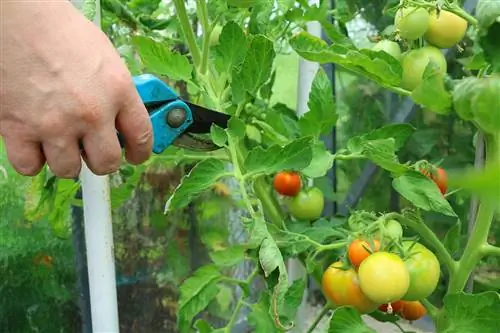
If the first signs of late blight and brown rot appear, quick action is required. The longer you wait to take action, the more the fungal spores will spread between the plants. If summer drought occurs and there is little damage, you can stop the disease by taking these measures:
- separate affected leaves, shoots and fruits with a sharp knife
- completely remove severely affected plants
- Do not dispose of plant parts in the compost, as the fungal spores survive here
- dispose of damaged plant material in the residual waste
Administer horsetail extract
Experiments by the State Agricultural Institute (LfL) have shown that the progression of the disease on leaves and shoots after a successful fungal infection was weakened by the administration of horsetail extract. In the early stages, the natural remedy proves to be an alternative to chemical products. The silica contained in the plant parts has a strengthening effect on the cell tissue. However, complete effectiveness could not be determined, so you should consider additional control agents as the brown spots continue to spread. How to make horsetail broth:
- fill large pot with horsetail herb
- pour warm water so that plant parts are completely covered
- Let stand at room temperature for 24 hours
- Bring the stock to the boil and simmer for half an hour
- mix cooled broth with water in a ratio of 1:5
- spray entire plant on three consecutive days
Note:
Fruits from infected plants are usually still edible. Harvest undamaged tomatoes early and let them ripen on the windowsill.
Combat chemically
Aside from horsetail broth, there are no effective, ecologically based remedies that help against the fungus. Once the disease has broken out, in most cases only chemical treatment can help. Some fungicides are approved for private use in home and allotment gardens. They are available under the names tomato-free, vegetable-free or fruit-mushroom-free. It makes sense to use several of these preparations alternately. Otherwise, the fungi quickly develop resistance and continue to spread.
Prevent illness
The most important measure to contain pathogens is to prevent splashing water on the leaves. To prevent spores from already infected parts of the plant from being washed onto he althy leaves and shoots, you should not water the plants from above. Pay attention to good hygiene when caring for and harvesting. Fungal spores often settle on utensils and survive until they reach suitable host plants. These recommendations are important:
- water close to the substrate
- clip off leaves close to the ground down to the lowest fruit stalk
- Disinfect spiral rods, secateurs and knives before use
Planting tomatoes correctly
The nightshade plants should be in a location that allows them to dry quickly after rain. Waterlogging in the substrate can also promote illness, as the evaporation water creates a moist microclimate. Compacted soils should first be loosened with a plow or sow tooth. The ideal location for Solanum lycopersicum looks like this:
- sunny and sheltered
- ideally under one roof
- well ventilated from all sides
- humus-rich substrate with small amounts of loam and clay
- soil loosened with sand
Keep your distance
Since potatoes and tomatoes are among the main host plants of the Phytophthora fungus, you should plant the species in the bed at a generous distance from each other. This means there is no contact and the risk of disease transmission through spores is lower. A minimum distance between individual tomato plants is also important so that the leaves dry well. If there is a moist microclimate between the plants, fungal spores can develop better. The distance applies not only spatially but also temporally, because crop rotation counteracts the spread of disease.
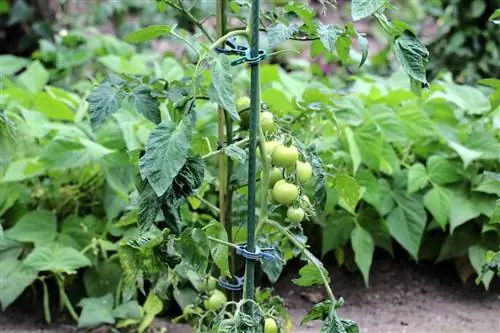
How to do it right:
- Plant potatoes at least 50 centimeters away
- Place tomato plants at a distance of 80 to 100 centimeters
- Plant young plants in a new bed every year
- do not use eggplant, pepper or physalis growth varieties for tomatoes
Tip:
Original species such as Humboldt tomato (Solanum humboldtii) or blackcurrant tomato (Solanum pimpinellifolium) are resistant to disease. The varieties 'Phantasia', 'Primavera', 'Philovita' and 'Primabella' prove to be more resistant.
Fertilize in a targeted manner
Pathogens have less chance of infection if the plants are he althy and growing vigorously. The correct supply of nutrients supports stable plant tissue so that fungal spores cannot penetrate the cell walls as easily. It is important for tomatoes to have a sufficient supply of potassium in order to prevent brown and late blight. The ideal fertilization involves three nutrient additions:
- work compost into the substrate before planting
- Administer about 50 to 80 grams of organic fertilizer after two months
- give some organic tomato fertilizer three to four weeks before harvest
Tip:
So that the plants become more robust against brown rot and late blight, you should spray the leaves weekly with plant broths. Manures made from horsetail, onion peels and garlic have proven successful.



